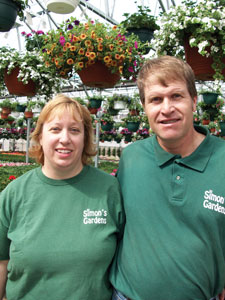12/15/2009
Branching Out
Barbara Mulhern

How does a small retail growing operation expand its customer base and pick up new high-end customers outside its primary geographic market? For Chris and Nancy Simon of Simon’s Gardens in Brookfield and Mukwonago, Wisconsin, it’s by constantly getting their names out at farmers’ markets and by coming up with new ways to promote their products based on current consumer trends.
“The hospitals are getting into nutritious food,” Chris says. “They are trying to get their employees to eat better.” So Simon’s set up produce stands at two nearby hospitals where doctors, nurses and other staff can buy fresh, locally grown fruit and vegetables during their shift changes. “These are high-end customers,” he says. “This is a good demographic to pick up. They may come back to buy plants from us in the spring.”
Chris and Nancy also carefully pick and choose the area farmers’ markets at which they sell their products. “These customers are the people you know won’t necessarily go down your street,” Chris says. “We give out our business cards, and we are probably getting an extra 10% of our new contacts from doing this. It helps replace customers who are moving out of our area,” he adds.
Simon’s Gardens, which does all of its growing in Mukwonago, has a total of about 20,000 sq. ft. of greenhouse growing space. Chris and Nancy grow nearly everything they sell themselves. They predominantly sell out of their Brookfield store, but when they expanded their greenhouse growing area in Mukwonago they did it with an eye to be “retail ready.” They now sell out of Mukwonago, as well.
Although Simon’s Gardens’ customer base is predominantly middle- and upper-end homeowners, “we are also seeing a lot of younger first-time homeowners,” Nancy notes. “There are a lot of confused younger people coming out of chain stores where they received no information, and then are wondering why their plants don’t grow.”
Tried and True
The Simon family has been growing produce in southeastern Wisconsin since 1852. The retail store in Brookfield is on the site of the old family farm. Throughout the years their products have changed. “In the 1950s the family was growing all types of things—they raised chickens, sold eggs and grew potatoes,” Chris says. “When I grew up, we had farm stands along the road. In the early 1980s we had a lot of requests from local sweet corn and vegetable customers who wanted (vegetable) plants to grow in their gardens.”
After that, the Simons began selling some marigolds and then found there was a high demand for bedding plants. By the mid-1980s, the greenhouse growing operation had moved more into flowering plants.
Today, Simon’s Gardens offers a wide variety of products to its retail customers, including numerous varieties of annuals, perennials, herbs and vegetables. “When the Proven Winners brand started coming out, a lot more of the middle-aged crowd was going for the new plants. This also brought in the younger crowd. But in the last couple of years the ‘tried and true’ [plants] have come back,” Chris notes.
“Maybe it’s the economy, as well,” he continues, “but we have seen more impatiens and geraniums that are good sellers. People don’t want to experiment as much. Price points have also become more of an issue. Customers have not wanted to spend more than $30 because of the uncertainty of the economy.”
Having more than one type of product has been a definite advantage during down economic times. “When the stock market fell in the fall of 2008 we had a tip-off,” Chris says. “Our decorative sales and the sales of pumpkins plummeted. With our higher-end customers, they felt like somebody took half of their money away.”
So Simon’s Gardens reduced its plantings in spring of 2009 by 20% to 25% and increased its vegetable and herb production to meet customers’ demands for locally grown fresh produce.
“We have the attitude that no sale is too small for us. That $3 okra customer may buy a lot more hanging baskets from us. We treat the person who comes in for a single tomato plant the same as our larger customers. That person could be a $500 customer next year,” Chris says.
Tips for Other Growers
Chris and Nancy have these tips for other small retail growers:
Start out very small. Find a couple of good grower “mentors” in the area. “In the beginning you should probably sell some of their products to find out what sells,” Chris suggests.
Make sure you have a good greenhouse. Chris and Nancy have naturally vented theirs. They suggest doing a lot of research to see what will work.
Always listen to customers’ complaints. A number of Simons’ customers complained about the plastic hangers they had been using. They either broke or wouldn’t fit into the eyehooks. Now Simons uses all wire hangars. It’s the “little things” that Chris believes sets Simon’s apart from its competitors.
Find ways to differentiate yourself. You may not be able to successfully compete solely on price. “So you have to find one thing in your area that hasn’t been done,” Chris says. “For example, it could be hanging bags or coco baskets—you could become the one supplier for your whole town. Or, you could have the widest ranging selection of vegetables,” he says.
Barbara Mulhern is a freelance writer from Verona, Wisconsin.